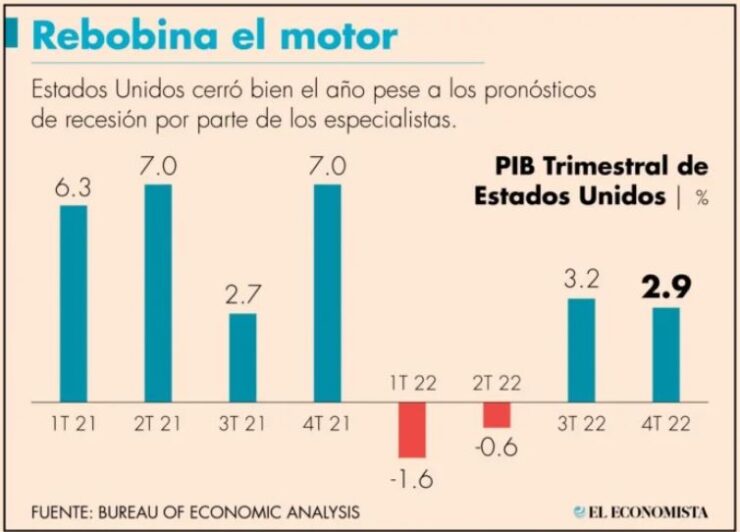
Gross Domestic Product (GDP) grew at an annualized rate of 2.9% in the fourth quarter of 2022, the Commerce Department reported Thursday in its fourth-quarter advance estimate. This growth is linked to the rise in the level of consumption of Americans at the end of that year.
The US economy maintained a strong pace of growth in the fourth quarter as consumers increased spending on goods, but momentum appeared to slow considerably towards the end of the year, with higher interest rates eroding demand.
The Gross Domestic Product (GDP) grew at an annualized rate of 2.9% last quarter, the Commerce Department reported Thursday in its forward estimate for the fourth quarter. Economists polled by Reuters had forecast GDP growth of 2.6 percent.
This could be the last quarter of strong growth before the lagged effects of the Federal Reserve’s tightening cycle, the fastest since the 1980s, kick in. Most economists forecast a recession for the second half of the year, albeit mild compared to previous recessions.
Retail sales have weakened sharply in the past two months and the manufacturing sector appears to have joined a recessionary housing market. Although the labor market remains strong, business confidence continues to deteriorate, which could end up hurting hiring.
The solid growth of the second semester erased the contraction of 1.1% of the first six months of the year. In 2022 as a whole, the economy expanded 2.1%, down from 5.9% in 2021. Last year, the Fed raised its key interest rate by 425 basis points, from near zero to a range of 4.25 % and 4.50%, the highest since the end of 2007.
Consumer spending, which accounts for more than two-thirds of US economic activity, was the main driver of growth, mainly reflecting a rebound in spending on goods early in the quarter. The spending has been supported by the resilience of the labor market, as well as excess savings accumulated during the Covid-19 pandemic.
However, demand for durable manufactured goods, which are mostly bought on credit, has waned and some households, especially lower-income ones, have depleted their savings. Business spending also lost some luster at the end of the fourth quarter.
recession in progress
Despite clear signs of weakness looming in 2023, some economists are cautiously optimistic that the economy will avoid a full-blown recession and instead suffer a creeping slowdown, with sectors declining in turns and not all at once.
They argue that monetary policy now acts with less lag than before, due to technological advances and the transparency of the US central bank, which, according to them, makes financial markets and the real economy act in anticipation of rate hikes.
Residential investment suffered its seventh consecutive quarterly decline, the longest streak since the collapse of the housing bubble triggered the Great Recession, but there are signs that the housing market may be stabilizing.
Mortgage rates have been trending lower as the Fed slows the rate of rate hikes.
A separate report from the Labor Department showed Thursday that initial claims for state jobless benefits fell by 6,000, to a seasonally adjusted 186,000, in the week ending Jan. 21.
The number of people receiving benefits after an initial week of aid, a rough indicator of hiring, increased by 20,000 to 1.675 million in the week ending January 14.
Companies outside the technology industry, as well as interest rate-sensitive sectors such as real estate and finance, are hoarding workers after struggling to find labor during the pandemic.
